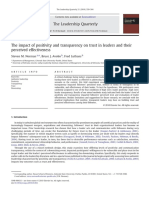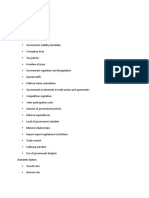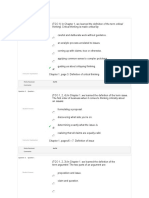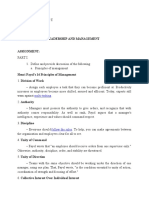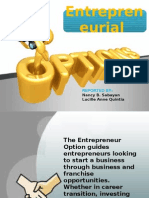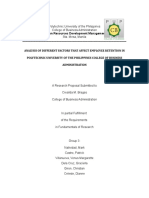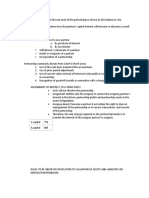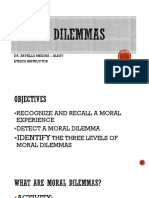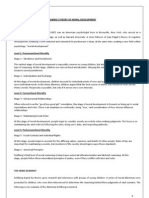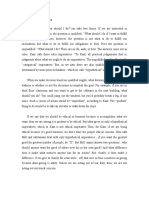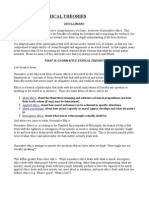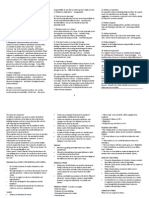0 ratings0% found this document useful (0 votes)
313 viewsMoral Deliberation and Moral Discernment
Moral Deliberation and Moral Discernment
Uploaded by
Girl Lang AkoThis document outlines a 7-step model for ethical decision making and a framework for moral deliberation. The 7-step model involves gathering facts, identifying stakeholders, articulating the dilemma, listing alternatives, comparing alternatives to principles, weighing consequences, and making a decision. The framework for moral deliberation further breaks down the process into identifying the problem, relevant facts, stakeholders, available options, and applying ethical principles from sources like utilitarianism, virtue ethics, and Christian teachings. The goal is to engage in a thorough process of analysis to arrive at the most ethical decision or resolution to a dilemma.
Copyright:
© All Rights Reserved
Available Formats
Download as DOCX, PDF, TXT or read online from Scribd
Moral Deliberation and Moral Discernment
Moral Deliberation and Moral Discernment
Uploaded by
Girl Lang Ako0 ratings0% found this document useful (0 votes)
313 views6 pagesThis document outlines a 7-step model for ethical decision making and a framework for moral deliberation. The 7-step model involves gathering facts, identifying stakeholders, articulating the dilemma, listing alternatives, comparing alternatives to principles, weighing consequences, and making a decision. The framework for moral deliberation further breaks down the process into identifying the problem, relevant facts, stakeholders, available options, and applying ethical principles from sources like utilitarianism, virtue ethics, and Christian teachings. The goal is to engage in a thorough process of analysis to arrive at the most ethical decision or resolution to a dilemma.
Original Description:
Ethics
Copyright
© © All Rights Reserved
Available Formats
DOCX, PDF, TXT or read online from Scribd
Share this document
Did you find this document useful?
Is this content inappropriate?
This document outlines a 7-step model for ethical decision making and a framework for moral deliberation. The 7-step model involves gathering facts, identifying stakeholders, articulating the dilemma, listing alternatives, comparing alternatives to principles, weighing consequences, and making a decision. The framework for moral deliberation further breaks down the process into identifying the problem, relevant facts, stakeholders, available options, and applying ethical principles from sources like utilitarianism, virtue ethics, and Christian teachings. The goal is to engage in a thorough process of analysis to arrive at the most ethical decision or resolution to a dilemma.
Copyright:
© All Rights Reserved
Available Formats
Download as DOCX, PDF, TXT or read online from Scribd
Download as docx, pdf, or txt
0 ratings0% found this document useful (0 votes)
313 views6 pagesMoral Deliberation and Moral Discernment
Moral Deliberation and Moral Discernment
Uploaded by
Girl Lang AkoThis document outlines a 7-step model for ethical decision making and a framework for moral deliberation. The 7-step model involves gathering facts, identifying stakeholders, articulating the dilemma, listing alternatives, comparing alternatives to principles, weighing consequences, and making a decision. The framework for moral deliberation further breaks down the process into identifying the problem, relevant facts, stakeholders, available options, and applying ethical principles from sources like utilitarianism, virtue ethics, and Christian teachings. The goal is to engage in a thorough process of analysis to arrive at the most ethical decision or resolution to a dilemma.
Copyright:
© All Rights Reserved
Available Formats
Download as DOCX, PDF, TXT or read online from Scribd
Download as docx, pdf, or txt
You are on page 1of 6
Moral Deliberation and Moral Discernment
A 7-Step Model for Ethical Decision-Making
1. Gather the Facts
Frequently ethical dilemmas can be resolved simply by clarifying the facts of the case in question. In those cases that
prove to be more difficult, gathering the facts in the essential first step prior to any ethical analysis and reflection on the
case. In analyzing a case, we want to know the available facts at hand as well as any facts currently not known but that
need to be ascertained. Thus one is asking not only “What do we know?” but also “What do we need to know?” in order
to make an intelligent ethical decision.
2. Identify the Stakeholders
The ethical issues are stated in terms of competing interests or goods. It’s these conflicting interests that actually make
for an ethical dilemma. The issues should be presented in a ______ versus ____ format in order to reflect the interests
that are colliding in a particular ethical dilemma. For example, in business ethics there is often a conflict between the
right of a firm to make a fair profit and its obligation to the community. In this case, that obligation pertains to the
environment.
3. Articulate the Dilemma
In any ethical dilemma, there are certain moral values or principles that are central to the conflicting positions being
taken. It is critical to identify these principles, and in some cases, to determine whether some principles are to be
weighted more heavily than others. Clearly, biblical principles will be weighted the most heavily. There may be other
principles that speak to the case that come from other sources. There may be constitutional principles or principles
drawn from natural law that supplement the biblical principles that come into play here. The principles that come out of
your sense of mission and calling are also important to consider.
4. List the Alternatives
Part of the creative thinking involved in resolving an ethical dilemma involves coming up with various alternative courses
of action. Although there will be some alternatives that you will rule out without much thought, in general the more
alternatives that are listed, the better the chance that your list will include some high-quality ones. In addition, you may
come up with some very creative alternatives that you had not considered before.
5. Compare the Alternatives with the Principles
At this point, the task is one of eliminating alternatives according to the moral principles that have a bearing on the case.
In many instances, the case will be resolved at this point, since the principles will eliminate all alternatives except one. In
fact, the purpose of this comparison is to see if there is a clear decision that can be made without further deliberation. If
a clear decision is not forthcoming, then the next part in the model must be considered. At the least, some of the
alternatives may be eliminated by this step of comparison.
6. Weigh the Consequences
If the principles do not yield a clear decision, then a consideration of the consequences of the remaining available
alternatives is in order. Both positive and negative consequences are to be considered. They should be informally
weighed, since some positive consequences are more beneficial than others and some negative consequences are more
detrimental than others.
7. Make a Decision
Deliberation cannot go on forever. At some point, a decision must be made. Realize that one common element in ethical
dilemmas is that there are no easy and painless solutions to them. Frequently the decision that is made is one that
involves the least number of problems or negative consequences, not one that is devoid of them.
Framework for Moral Deliberation
1. Identifying and setting up the Ethical Problem
What is the ethical problem? First, the ethical problem must be identified. It helps to be able to state or define,
succinctly, the ethical issue involved in the case and to make sure that this is not confused with other elements of the
problem. (Perhaps the ethical problem can be stated in one or two sentences – very much like a thesis statement that
defines the problem to be tackled).
It is important to realize that every ethical problem has more than one component and that not every component
involves an ethical decision. For example, in a case involving a decision to bribe or not to bribe a government employee
to speed up the process of granting your application for a business license. This employee is not asking for much; besides
he is underpaid. We should separate the fact that the employee is underpaid from the ethical problem of bribing. And
the issue should be stated clearly. The question is not whether the employee is underpaid and so there is injustice in
that regard, but whether you should bribe him to expedite things that is ethically problematic.
2. What are the relevant facts?
What immediate facts have the most bearing on the ethical decision that must be made in this case? Include any
potential economic, social, or political pressures.
We need to list only the fact that bear on ethical decision. Sometimes, we arrive at wrong moral decisions because we
have not really taken the relevant facts into consideration, or we have taken more than the necessary facts into
consideration. For example, that there are most honest women than men employed by the government has no bearing
on the question of whether or not to bribe.
3. Who are the stakeholders?
It is important to identify the stakeholders who will be affected by the ethical decision to be made. It will also help to
identify the corresponding obligations that one has toward the various stakeholders. For instance, one must consider
the stakeholder who stands to lose more from the decision more seriously than others.
This is the first point at which ethical theories can be applied since the idea of moral stakeholders can be tied both to
consequential and non-consequential theories. For example, from a utilitarian perspective, the interest of the majority
must be taken into consideration – therefore, the majority stakeholders must be recognized as group. Non-
consequential theories (duty-based) require us to be aware of all stakeholders potentially affected by our decision.
Recognized duties – like justice, gratitude, self-improvement, etc. – allow us not only to list stakeholders but also to
decide on who they are. For example, if, as a government employee, you are obligated by the duty of service to honor
your implied contract with the public to give them the service they require, that public must be listed as a stakeholder in
your decision.
At this stage too, it will also help to get to know the perspective of the stake holders. One can do this by stepping into
the shoes of the various claimants and trying to determine, as honestly as one can, what they would prefer you to do in
this situation. This is one of the most difficult tasks in ethical decision-making. The key here is to try your best to see the
problem from their perspectives.
4. What are the available options?
It is important to list down at least three or even more available options. As Aristotle says, there are at least two options
readily available from the very beginning, and these two often represent the extremes. But nothing is ever either black
or white; sometimes one is forced to think in terms of a "middle ground," even if that, strictly speaking, does not exactly
conform to your personal notion of what is the right thing to do. A genuine "Golden Mean" is not simply a watered-
down decision; in fact, it bears the marks of the internal struggle that accompanies every bit of hard thinking. It is at this
stage that reason struggles to transcend what we feel.
In considering and evaluating the options it will help to be guided by ethical principles. This is the point at which the
various sources of Christian morality, ethical theories and principles could come into play. These various considerations
and approaches for moral decision-making may also be stated in the following questions:
- What benefits and what harms will each option produce, and which alternative will lead to the best overall
consequence? (Utilitarianism)
- What moral rights do the affected parties have, and which option best respects those rights? (Kant)
- Which course of action advances the common good? - Which decision enables me to be and act in ways that
develop my highest potential as a person? (Virtue)
- Which option treats everyone the same, except where there is a morally justifiable reason not to, and does not
show favoritism or discrimination? (Justice and Fairness)
One will discover here that there could be much conflict among these principles. There are no easy solutions. While
one person may use utilitarianism to support his decision, another may decide to cite Kant's universalizing principle
against using any person as a means to an end. What is important here is to use only those justifications that apply
directly to one's decision.
Brief Explanation of Some Ethical Principles
a. Christian Resources. The Christian moral life derives from (and therefore, moral decisions should be inspired
by) the sacred books of the Old and New Testaments, in particular from the ideas, values, and concerns of Jesus Christ.
In other words, the moral teachings of the biblical writings should be consulted whenever necessary. Since we are a
Church – a Christian community – our moral decisions should also be informed by the official teachings of the
ecclesiastical magisterium and the concrete practice adhered to by the Church. Ecclesiastical magisterium here refers to
the teachings of the councils and the pope, bishops’ conferences.
Christian reflection has concluded that all beings not only come from God as their First Cause but also return to Him as
to their perfection as the Final Cause. Thus, the Final Goal of the human being according to which he acts deliberately by
reason is God Himself. Thus, we can also glean that the ethical life is one that pursues the absolute Good as its end, its
fulfillment and perfection. Karl Peschke writes –
“If man has been given an objective final end by the Creator, he will be under the obligation to make to make this
objective end his subjective end – in other words, to strive after it. And when he looks to that end, an order which has to
be followed will become visible to him: the moral order. This moral order is shown to us through the moral law.”
b. Common-Good. One can trace the beginnings of the notion of common good back to such philosophers as
Plato, Aristotle, etc. The notion supposes that the good of individuals is inextricably linked to the good of the polis, the
community. Thus for Aristotle, ethics is really a prologue to politics.
The common good consists primarily of having social institutions, and environments working effectively for the benefit
of all people. An example of a particular common good would be the public health care system. The maintenance of the
common good requires the cooperative efforts of citizens. But these efforts pays off – in the form of a good or goods to
which all members of society have access, and from whose enjoyment no one can be easily excluded.
c. Virtue (Prudence, Justice, Temperance, Fortitude). This theory referred to as “Ethics of Being” as opposed to
“Ethics of Doing”. It assumes that there are certain ideals toward which we should strive, which provide for the full
development of our humanity. We discover this ideals by reflecting on what kind of people we have the potential to
become. Virtues are attitudes or dispositions that enable us to be and to act in ways that develop our highest potential.
They enable us to pursue the ideals we have adopted. Examples of virtues are honesty, courage, compassion, integrity,
fairness, temperance, prudence, etc. When one uses the virtue theory in making decision, the fundamental question is
“What kind of person will I become if I make this decision?” There is emphasis on “be-ing”.
We develop virtues through learning and through practice. Aristotle suggested that virtues are habituated. Once
acquired, a virtue becomes a characteristic of a person. For example, a person who has developed the virtue of
generosity is referred to as a generous person because he tends to exhibit this characteristic in all that he does.
A very important idea, which is at the heart of the virtue approach, is “community”. a person’s character traits are not
developed in isolation, but always within and by the communities in which he belongs – the family, church, school, etc.
Thus, this virtue approach invites us to pay attention to the well-being of our communities because they also shape the
kind of person we become.
The moral life, then, is not simply following moral rules. It is also a matter of trying to determine the kind of persons we
should be and of attending to the development of character within our communities and ourselves.
d. Rights. What is right? Simply stated, a right is a justified claim on others, For example, if I have a right to
property, then I have a justified claim to protect my belongings against those who might steal them. The reverse is also
true: Others have the responsibility to respect my property. Usually, this claim to a right is acknowledge not just by the
individual but also by society – more concretely, the Constitution, which guarantees all sorts of rights.
This theory has its roots in the philosophy in the 18 th century philosopher Immanuel Kant and others. He suggests that
what makes human beings different from mere things is that they have dignity based on their ability to choose freely
what they will do with their lives. Because people are rational, they have a fundamental moral right to have these
choices respected. People are not objects to be simply manipulated or used merely as means to ends. To treat a person
as a mere means is to use a person to advance one’s own interest. On the other hand, to treat a person as an end is to
respect that person’s dignity by allowing him the freedom to choose for himself.
This basic right of the person to choose for himself is often used to justify other rights. First, we have so-called negative-
rights – right to privacy, the right not to be killed, or the right to do what one wants with one’s property, etc. These are
negative rights because each imposes a negative duty or obligation on us – for example, the right to privacy imposes the
obligation on us not to intrude into the private activities of a person. Second, we also have the so-called positive or
welfare rights. These are rights that provide something that people need to secure their well-being – like the right to an
education, right to food, the right to housing, or the right to a job. These positive rights flow from the fundamental right
to freedom which implies that every human being has a fundamental right to have what is necessary to secure a
minimum level of well-being.
Sometimes, the rights of individuals can come into conflict. In cases like this, we need to examine the interests at stake
and decide which of the two is the more crucial for securing human dignity. Sometimes too the social costs or the
injustice that would result from respecting a right can be too great. So, while morality certainly calls for respect of
individual rights, we must also be aware of its social repercussions. We must also consider that sense of community,
shared values, and common good that lend itself to an ethics of care, compassion, and concern for others.
e. Utilitarianism. Conceived in the 19th century by Jeremy Bentham and John Stuart Mill, this theory suggests
that ethical actions are those that provide the greatest balance of good (pleasure) over evil (pain) for the most number
of people. There is hardly a case in which carrying out an option will not harm someone. By listing down the options and
concomitant harms, one is made to weigh the amount of potential harm involved in each alternative and to understand
that avoiding harm is practically impossible. As utilitarian suggest, in the end, it may be best to choose the option that
will produce the least amount of harm. That option (decision) will be chosen that will produce the greatest benefits and
the least harm.
f. Justice and Fairness. No idea has been more consistently linked to ethics and morality than that of justice. But
what does justice mean? In traditional terms, justice means giving each person what he or she deserves, or what his or
her due. Thus, justice requires that a man get paid according to the work he has does. Or burdens and benefits should
be distributed equally among members of a group.
But what criteria should we use to determine what is somebody’s due?
The most fundamental principle of justice is one first defined by Aristotle: “Equals should be treated equally and
unequals unequally”. This principle can also be expressed thus – “Individuals should be treated the same, unless they
differ in ways that are relevant to the situation in which they are involved”. For example, if John and Jane do the same
work, and there are no relevant differences between them or the work they are doing, then in justice they should be
paid the same wages. If John is paid more because he is a man, the, justice has not been served.
There are however, some differences that can be justifiable criteria for treating people differently. The Church, for
instance, advocates what it calls a "preferential option for the poor". This preference is premised on the fact that the
poor are from the very beginning already "unequal" relative to the wealthy. Because of this social disparity, there are
opportunities for human development that are out of their reach. In dealing with them, then, there is a need to
"equalize" things first before justice can be served. In other words, there is room here not just for justice, but justice and
fairness. Justice and fairness, then, is a central part of ethics and should be given due consideration on our moral lives.
5. Determine the Most Appropriate Best Course of Action.
On the basis of the evaluation done on the various options, we must now determine the best course of action - the
moral thing to do. Ethicists claim that this is the most difficult part of the process of moral decision-making. It requires
courage - especially when reason suggests one way and what we feel another way.
Some people make their decisions even prior to the reasoning process. When this happens, it is possible to end up with
a decision that one can then rationalize but not really justify.
6. Double-Checking one's decision
It is important to take a second look at the decision to be made. The following are suggested ways of doing precisely
that:
First, we must see to it that our arguments and the position we take are consistent. Ethics is supposed to provide us with
a guide for moral living, and to do so, it must be rational - that is, free of contradictions.
Second, we must also ask if our arguments are both valid and sound. A valid argument is one whose premises logically
entail its conclusion. An invalid argument on the other hand is one whose premises do not entail its conclusion. In an
invalid argument, one can accept the premises as true and reject the conclusion without any contradiction. A sound
argument, on the other hand, has true premises and valid reasoning. An unsound argument employs invalid reasoning or
has at least one false premise.
Third, perhaps we can ask the following questions: What are the best and worst case scenarios if I choose this particular
option? Can I honestly live with myself if I make this decision? Will I be able to defend this decision to that claimant who
has lost the most or been harmed the most?
Finally, our decision must be "enabling" rather than "dis-abling" There are decisions that prevent us from acting any
more fruitfully or effectively. These decisions cannot be moral! After all, a moral decision or action is one that liberates
us - develops our potentialities as a person. A decision that "dis-ables" us prevents our growth as persons. Catholic
moral and pastoral traditions have always makes a distinction between "ought" and "can". This distinction is helpful in
double-checking our decisions.
We quote Richard Gula here –
"Ought" expresses the objective pole of morality. This imperative is what ethical reflection tries to uncover. Such
reflections yield statements of right and wrong, such as "euthanasia is wrong" and "keeping promises is right". “Can"
expresses the subjective pole of a person's capacity to choose right or wrong. This is the area that pastoral guidance
needs to respect.
According to this distinction, the “ought” refers to the way life ought to be lived. Objective morality is the world of value
that we must confront in making moral decisions. The “can” on the other hand, refers to the “art of the possible”.
The subjective pole of morality has to do with the behavior that flows from one’s capacity of knowledge, freedom, and
emotion to appreciate moral values, to commit oneself to them, and to choose them freely. Pastoral guidance is
concerned with the ability of a person to fulfill the objective moral order. In other words, it seeks the best possible
expression of basic human goods that this person can make at this time to satisfy what love demands. “Love one
another as I have loved you” is a norm for life and so must be followed constantly. But there is a limit to what can be
done by each person at each time in order to live truthfully, compassionately, and respectfully of self and others. To
refuse to accept this is to demand perfect love from imperfect creatures. To face the reality of human sinfulness and to
accept our limited ability to love is not to dissolve the gospel demand but to recognize that we are still in need of
conversion. We are still on the way to the full flowering of love.
You might also like
- Time Sharing Space Case Study Business EthicsDocument2 pagesTime Sharing Space Case Study Business EthicsWaqarNo ratings yet
- Song For Brother PDFDocument2 pagesSong For Brother PDFGirl Lang Ako0% (2)
- Albay Emergency Response and Report Tool (Alerrt)Document17 pagesAlbay Emergency Response and Report Tool (Alerrt)CS & ITNo ratings yet
- Perpetual Mercy Hospital Swot Analysis PDFDocument6 pagesPerpetual Mercy Hospital Swot Analysis PDFStacey SalvillaNo ratings yet
- Motivational Theory in ManagementDocument9 pagesMotivational Theory in Managementsamantha_davidsonNo ratings yet
- Contemporary Nursing TheoriesDocument13 pagesContemporary Nursing Theoriessagami.gNo ratings yet
- Conceptual Framework of The Nursing Management ProcessDocument1 pageConceptual Framework of The Nursing Management ProcessJustin Ahorro-Dionisio100% (1)
- Unfreezing, Changing and RefreezingDocument28 pagesUnfreezing, Changing and RefreezingMylene Almonte NocasaNo ratings yet
- Mores Sec DefinitionDocument2 pagesMores Sec DefinitionMark BequilloNo ratings yet
- CombinationDocument57 pagesCombinationGirl Lang Ako100% (1)
- ARUP - Ethical Conduct PolicyDocument1 pageARUP - Ethical Conduct PolicyAlparslan GureNo ratings yet
- List of 600 Personality TraitsDocument8 pagesList of 600 Personality TraitsCtmanis NyerNo ratings yet
- The Impact of Positivity and Transparency On Trust in Leaders and Their Perceived Effectiveness0 PDFDocument15 pagesThe Impact of Positivity and Transparency On Trust in Leaders and Their Perceived Effectiveness0 PDFneeraj00715925No ratings yet
- Different Types of ExcellenceDocument5 pagesDifferent Types of ExcellenceVasant ModiNo ratings yet
- Planning ReportDocument14 pagesPlanning ReportReylan GarciaNo ratings yet
- Centralized and Decentralized Organizational Structures 1Document3 pagesCentralized and Decentralized Organizational Structures 1VivekNo ratings yet
- Working With ColleaguesDocument81 pagesWorking With ColleaguesMehmood Aslam75% (4)
- Performance Appraisal Case StudyDocument2 pagesPerformance Appraisal Case StudyCrystal MugfordNo ratings yet
- Weebly Professional Development Plan FeedbackDocument3 pagesWeebly Professional Development Plan Feedbackapi-241839714No ratings yet
- Comprehensive Case StudyDocument8 pagesComprehensive Case Studyapi-634419348No ratings yet
- PESTEL AnalysisDocument7 pagesPESTEL AnalysisArslan TariqNo ratings yet
- Paper 5 - Making The Right DecisionDocument15 pagesPaper 5 - Making The Right DecisionchitocsuNo ratings yet
- Henry Laurence Gantt: The Gantt Chart ThinkerDocument12 pagesHenry Laurence Gantt: The Gantt Chart ThinkerMary Dale Joie BocalaNo ratings yet
- The Philippine Qualification System and The Reform in The Nursing EducationDocument5 pagesThe Philippine Qualification System and The Reform in The Nursing EducationDennis Nabor Muñoz, RN,RMNo ratings yet
- Final Exam Phil 447 Logic and Critical ThinkingDocument7 pagesFinal Exam Phil 447 Logic and Critical ThinkingTommie100% (2)
- Ethical Dilemma AssignmentDocument2 pagesEthical Dilemma AssignmentClaire GreenleeNo ratings yet
- Ground RulesDocument2 pagesGround RulesSovan PadhiNo ratings yet
- Global Issues IN: Strategic ManagementDocument8 pagesGlobal Issues IN: Strategic ManagementabhishekdarraNo ratings yet
- Ethical Leadership & Whistle BlowingDocument10 pagesEthical Leadership & Whistle BlowingSaf Wan100% (1)
- Nurse Patient InteractionDocument17 pagesNurse Patient InteractionAbigail MangaoangNo ratings yet
- Literature Review-Case Studies in NursingDocument6 pagesLiterature Review-Case Studies in Nursingapi-376910880No ratings yet
- Ethical Final EssayDocument6 pagesEthical Final EssayTitus KoechNo ratings yet
- Entrepreneurial CompetenciesDocument6 pagesEntrepreneurial CompetenciesshanumanuranuNo ratings yet
- Henry Laurence Gantt AND His TheoryDocument15 pagesHenry Laurence Gantt AND His TheoryAlain Dave100% (2)
- Leadership - Taberna, Catherine TDocument12 pagesLeadership - Taberna, Catherine Taaron tabernaNo ratings yet
- Strategic Planning ProcessDocument6 pagesStrategic Planning ProcessramanmarriNo ratings yet
- Nurse EntrepreneurshipDocument3 pagesNurse EntrepreneurshipWendy EscalanteNo ratings yet
- Reaction PaperDocument5 pagesReaction PaperMohlisah Madid MonadatoNo ratings yet
- Click To Edit Master Subtitle Style: Reported byDocument19 pagesClick To Edit Master Subtitle Style: Reported byNancy Borlasa0% (1)
- Factors Influencing Human Resource Management FunctionsDocument7 pagesFactors Influencing Human Resource Management FunctionsSujith M NairNo ratings yet
- Power of SupervisionDocument7 pagesPower of SupervisionKhenz MistalNo ratings yet
- Drugs Affecting The Body System - Endocrine SystemDocument69 pagesDrugs Affecting The Body System - Endocrine SystemFaye JavierNo ratings yet
- Local Government Unit City Health Office 1Document4 pagesLocal Government Unit City Health Office 1alfonsoNo ratings yet
- UNIT 6 DirectingDocument27 pagesUNIT 6 DirectingPreeti BhaskarNo ratings yet
- Reflection Legs WebinarDocument2 pagesReflection Legs WebinarKenjie MondoyNo ratings yet
- The Top 10 Work Values Employers Look ForDocument5 pagesThe Top 10 Work Values Employers Look FormanalivatvishaNo ratings yet
- QUALMANCase 3Document7 pagesQUALMANCase 3JOANNECHUNo ratings yet
- Business Plan PSRF (Updated)Document14 pagesBusiness Plan PSRF (Updated)Paul symon frutoNo ratings yet
- Chapter 1 - The Problem and Its BackgroundDocument10 pagesChapter 1 - The Problem and Its BackgroundJeshua Llorera50% (2)
- Mariano, Znyx Aleli J. Bse-Filipino 1 Module 9: Feelings and Moral Decision-Making A. BackgroundDocument5 pagesMariano, Znyx Aleli J. Bse-Filipino 1 Module 9: Feelings and Moral Decision-Making A. BackgroundZnyx Aleli Jazmin-MarianoNo ratings yet
- Organizing in NursingDocument42 pagesOrganizing in NursingIvan Mendoza100% (2)
- Health Education Individual Assignment #4 (Case Study)Document3 pagesHealth Education Individual Assignment #4 (Case Study)Kiana OcampoNo ratings yet
- Development of Human SexualityDocument3 pagesDevelopment of Human SexualityNikhil MohanNo ratings yet
- Human Resource Management: Assignment 2Document7 pagesHuman Resource Management: Assignment 2Nour FawazNo ratings yet
- Weekly Accomplishment ReportDocument7 pagesWeekly Accomplishment ReportJhoan Reblora CervantesNo ratings yet
- Science, Technology & Society Module 9Document5 pagesScience, Technology & Society Module 9Earl Daniel PulpulaanNo ratings yet
- Force Field AnalysisDocument3 pagesForce Field AnalysisalinaNo ratings yet
- Managerial Roles 1Document11 pagesManagerial Roles 1Thomas CheahNo ratings yet
- Curriculum Vitae (CV) : 1. Personal Information Sisay Niguse AsefaDocument1 pageCurriculum Vitae (CV) : 1. Personal Information Sisay Niguse AsefaEfrem WondaleNo ratings yet
- Analyzing A Leader EssayDocument6 pagesAnalyzing A Leader Essayapi-253792021No ratings yet
- Health Care Delivery System 1Document21 pagesHealth Care Delivery System 1Carson BirthNo ratings yet
- Finals: Lesson 10: ForumDocument9 pagesFinals: Lesson 10: ForumLyn AbudaNo ratings yet
- Force Field Analysis - Kurt LewinDocument5 pagesForce Field Analysis - Kurt Lewinhoooza janaykaNo ratings yet
- Oral Eliberation: Michael J. SandelDocument7 pagesOral Eliberation: Michael J. SandelAlliah Navarro Marquez IINo ratings yet
- Dayag Notes Partnership FormationDocument3 pagesDayag Notes Partnership FormationGirl Lang AkoNo ratings yet
- Dayag Notes Partnership DissolutionDocument3 pagesDayag Notes Partnership DissolutionGirl Lang AkoNo ratings yet
- Or Defined Benefit Plans - Such May Be Contributory or NoncontributoryDocument7 pagesOr Defined Benefit Plans - Such May Be Contributory or NoncontributoryGirl Lang AkoNo ratings yet
- Inventories: PERIODIC SYSTEM-physical Counting of Goods OnDocument4 pagesInventories: PERIODIC SYSTEM-physical Counting of Goods OnGirl Lang AkoNo ratings yet
- And For What Purpose The Asset Is Used Throughout The Period of UseDocument9 pagesAnd For What Purpose The Asset Is Used Throughout The Period of UseGirl Lang AkoNo ratings yet
- Returned To The SH in Any Form During TheDocument5 pagesReturned To The SH in Any Form During TheGirl Lang AkoNo ratings yet
- TaxationDocument3 pagesTaxationGirl Lang AkoNo ratings yet
- and Highly Liquid Investment Readily Convertible Into CashDocument3 pagesand Highly Liquid Investment Readily Convertible Into CashGirl Lang AkoNo ratings yet
- Accounting For Income TaxDocument6 pagesAccounting For Income TaxGirl Lang AkoNo ratings yet
- Justice and FairnessDocument5 pagesJustice and FairnessGirl Lang Ako100% (1)
- Derivatives (Pfrs9) : of An Asset Like Investments in TradingDocument4 pagesDerivatives (Pfrs9) : of An Asset Like Investments in TradingGirl Lang AkoNo ratings yet
- Cash and Marketable Securities Seatworks PDFDocument3 pagesCash and Marketable Securities Seatworks PDFGirl Lang AkoNo ratings yet
- Afar 8708franchise PDFDocument4 pagesAfar 8708franchise PDFGirl Lang AkoNo ratings yet
- RFBT8701 ObligationDocument34 pagesRFBT8701 ObligationGirl Lang AkoNo ratings yet
- "Is Business Bluffing Ethical?": by Albert CarrDocument4 pages"Is Business Bluffing Ethical?": by Albert Carrpeachrose12No ratings yet
- Moral DilemmasDocument24 pagesMoral DilemmasArvella Albay67% (3)
- Darwall Theories of Ethics Chp2Document21 pagesDarwall Theories of Ethics Chp2Tzoutzoukina100% (1)
- How Would You Describe YourselfDocument5 pagesHow Would You Describe YourselfGoia PullNo ratings yet
- Invention of LyingDocument2 pagesInvention of LyingPalaDinNo ratings yet
- Intentional InjuriesDocument30 pagesIntentional InjuriesZyryx BartolomeNo ratings yet
- Turnipseed 2002Document15 pagesTurnipseed 2002Padmo PadmundonoNo ratings yet
- Kohlberg's Theory of Moral DevelopmentDocument4 pagesKohlberg's Theory of Moral DevelopmentRENJULAL100% (5)
- Contemporary Moral Problem Book ReviewDocument50 pagesContemporary Moral Problem Book ReviewYumiko MatsuoNo ratings yet
- Jesse Prinz 22morality Is A Culturally Conditioned Response 22Document5 pagesJesse Prinz 22morality Is A Culturally Conditioned Response 22api-503540773No ratings yet
- 4 The Filipino Value System and Business EthicsDocument10 pages4 The Filipino Value System and Business Ethicsrommel legaspiNo ratings yet
- American Nurses Association Code of EthicsDocument2 pagesAmerican Nurses Association Code of Ethicsagung sedanaNo ratings yet
- Ethics Module 2Document5 pagesEthics Module 2Aaroh TorresesNo ratings yet
- Etika ProfesiDocument6 pagesEtika ProfesiNisa Juwita AdhimNo ratings yet
- MFQ30 Self-ScorableDocument2 pagesMFQ30 Self-ScorableBona BonaNo ratings yet
- Character Strengths and Virtues A Handbook of Classification MindmapDocument1 pageCharacter Strengths and Virtues A Handbook of Classification MindmapJorge Luis Villacís NietoNo ratings yet
- Normative Ethical TheoriesDocument12 pagesNormative Ethical TheoriesIM50% (2)
- High School MBTIDocument11 pagesHigh School MBTIDianaCastleNo ratings yet
- Professional Ethics Class Notes Set 1 and 2Document13 pagesProfessional Ethics Class Notes Set 1 and 2Kalasekar M Swamy50% (2)
- Exercise 7Document5 pagesExercise 7NL Castañares84% (19)
- Business Ethics Concepts & Cases: Manuel G. VelasquezDocument21 pagesBusiness Ethics Concepts & Cases: Manuel G. VelasquezFariza SiswantiNo ratings yet
- Reflections On EthicsDocument2 pagesReflections On EthicsHazim HsNo ratings yet
- Animal Ethics Chapter 1Document23 pagesAnimal Ethics Chapter 1JeronimoEzqNo ratings yet
- Ross EthicsDocument2 pagesRoss EthicsSuzette Rae TateNo ratings yet
- Dimensions of EthicsDocument3 pagesDimensions of Ethicsbipin09103034100% (1)
- Ethical Theories Business PDFDocument2 pagesEthical Theories Business PDFDavid0% (1)
- Design Constraints of EthicsDocument2 pagesDesign Constraints of EthicsVamsi MuddamNo ratings yet
- What Is Ethical Egoism?: Should I Always Pursue Only My Own Self-Interest?Document5 pagesWhat Is Ethical Egoism?: Should I Always Pursue Only My Own Self-Interest?Midnight RosenfieldNo ratings yet












